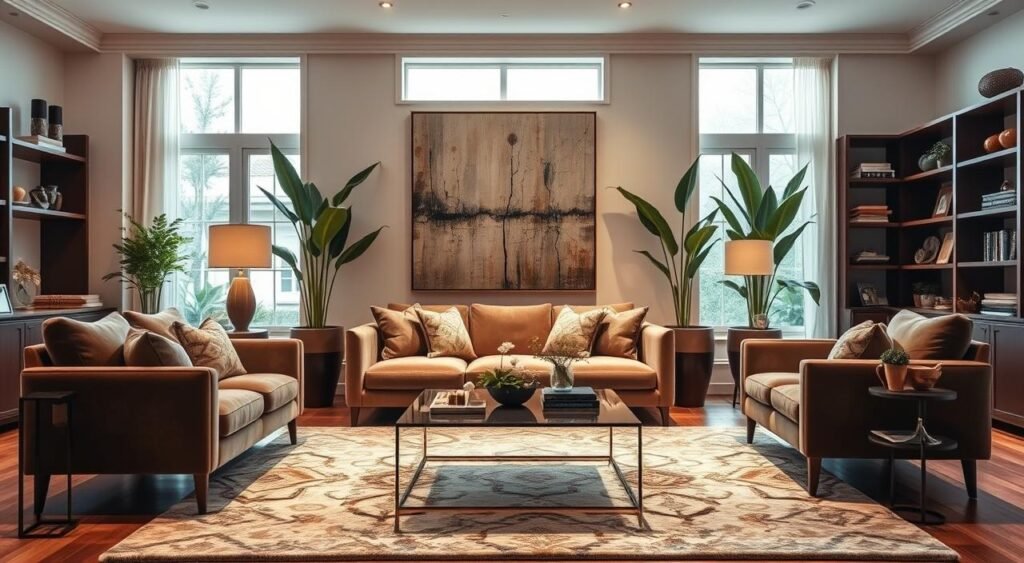Ever wonder why your living room feels off, even with trendy decor? Let’s simplify things. Home decor 101 isn’t about achieving perfection. It’s about making smart choices that reflect your life. Imagine a space where every piece, from that rustic console table to your favorite artwork, harmonizes.
I’m here to simplify interior design basics. This way, you can stop overthinking and start creating. It’s time to turn your space into a reflection of your style.
Key Takeaways
- Blend French Country elegance with modern accents to avoid a cluttered look.
- Rustic wood and metal mixes add instant edge without breaking the bank.
- Pastel shades in kitchens create French Country charm on any budget.
- Neutral color schemes let accent walls become statement-makers without overwhelming.
- Smart storage solutions like under-stairs seating double function and style.
Ready to turn your dreams into reality? This guide shows how small changes can lead to big transformations. No more guessing games. Let’s make your home a place you’ll love coming home to.
Understanding the Fundamentals of Home Decor 101
Let’s begin with the basics! Whether you’re setting up your first apartment or giving your home a complete makeover, home decor 101 starts with understanding what makes a space both beautiful and functional. Are you ready to dive in? Let’s break it down.
Defining Your Personal Aesthetic
Every great space begins with knowing your style. Ask yourself: Do you prefer clean lines and simplicity, or do bold patterns and global textiles excite you? Use these interior design basics to explore your style:
- Create a Pinterest board to pin looks that inspire you.
- Visit showrooms or design blogs to spot trends that resonate.
- Test styles like bohemian (vibrant textures) or minimalist (clean lines) to see what feels most “you.”
| Style | Key Features |
|---|---|
| Modern | Clean lines, neutral palettes, sleek materials |
| Bohemian | Bold patterns, global textiles, organic elements |
| Traditional | Ornate details, rich fabrics, symmetrical layouts |
The Relationship Between Function and Design
“A well-designed living room should be a sanctuary that reflects your personality and lifestyle.” – Nate Berkus
Design isn’t just about looks—it’s about living. Ask: Where will your family gather? How do you entertain? Balance aesthetics with practicality. A cozy reading nook? Add a floor lamp and storage. Need a workspace? Choose furniture that fits your habits. Beginner home decor ideas start here—always ask, “Does this work for me?”
Building a Foundation for Beautiful Spaces
Begin with the basics: color, layout, and flow. Start with a neutral base—think whites, grays, or warm beiges—to create a canvas. Then layer in bold accents through art, textiles, or furniture. Remember: A 50/50 split of bold and neutral tones keeps spaces balanced.
Tip: Use area rugs to anchor seating arrangements and define zones. Mix textures—velvet, linen, and wool—to add depth without overwhelming your room.
Color Theory: The Building Block of Beautiful Rooms
Ever ponder why some rooms energize you while others feel like a warm hug? It’s all about color theory, the hidden ingredient that shapes these moods. Start with the primary colors (red, blue, yellow), the base of all hues. Mix them to get secondary colors like green or purple. Blend further for tertiary shades, adding depth. It’s like painting with blocks!
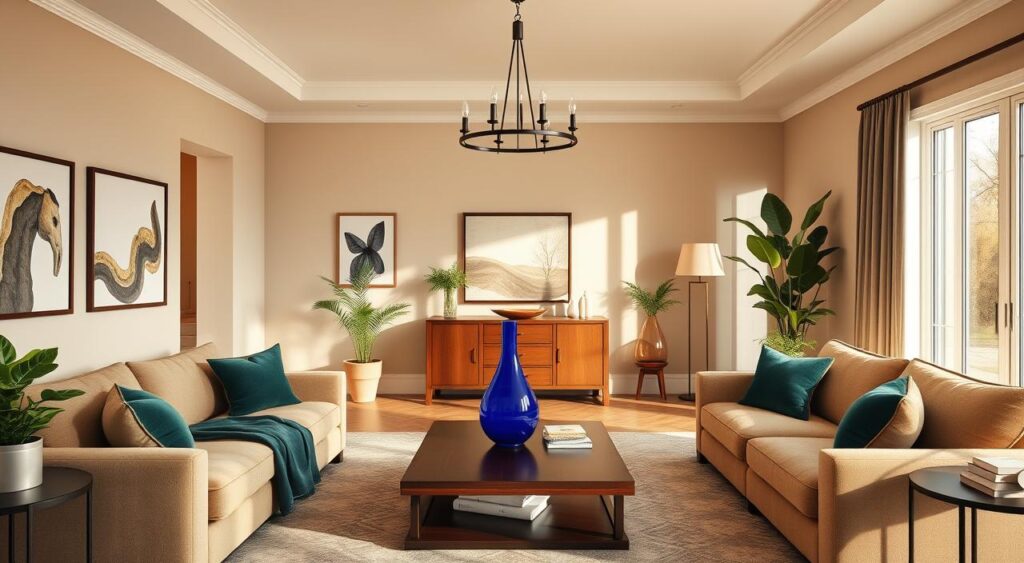
Follow the 60-30-10 rule for effortless home decorating tips: 60% for the dominant color (walls), 30% for the secondary (furniture), and 10% for the accent (decor). For instance, a navy blue sofa (60%) pairs well with beige curtains (30%) and gold accents (10%). Want a mood lift? Warm tones like orange energize spaces, ideal for kitchens. For a calming effect, cool blues and greens are perfect in bedrooms.
- Monochromatic: Play with shades of one color (e.g., light/dark grays)
- Analogous: Use neighbors on the color wheel (like blue + teal)
- Complementary: Contrast opposites (red + green) for bold drama
Pro interior design basics tip: Test paint samples under natural light! That sunset-orange wall might appear neon in daylight. And remember, your personal taste is key. If mint green makes you smile, go for it! Color rules are guidelines, not strict laws.
Creating Balance and Proportion in Every Space
Ever walked into a room and felt something’s off? It’s probably balance and proportion. Let’s explore three interior design basics that transform chaotic spaces into cohesive ones. Ready to master them? Let’s dive in!
The Rule of Thirds in Interior Design
Imagine your room as a 3×3 grid. Divide walls and floors into thirds to avoid centering everything. Hang art slightly off-center—it draws the eye without feeling stagnant. Home decorating tips like this are magic: use painter’s tape to sketch grids on floors before arranging furniture. Group decor in odd-numbered clusters (three vases, five books) for dynamic energy.
Visual Weight: Creating Harmony
Dark colors and chunky textures carry more visual weight than light, smooth surfaces. Balance a bold sofa with sleek side tables. Mix patterns but anchor with one heavy element—a large rug or statement wall. Even asymmetrical rooms can feel grounded when heavier items sit in corners.
Scale and Proportion: Sizing Matters
Nothing screams “off” like a tiny rug under a sectional. Rugs should hit at least 2/3 of a bed’s length. Dining tables? A chandelier should be 60-75% the table’s width. Home decorating tips to remember: measure twice! A 9×12 rug under an 84” sofa looks right—no guessing. Artwork? Keep it half to two-thirds the width of the furniture below it.
Start small if you’re nervous. Swap that tiny coffee table for a slightly larger one. Trust these interior design basics, and watch clutter turn into calm. Your space will thank you!
Lighting Essentials: How to Illuminate Your Home Like a Pro
Lighting is the secret sauce of any space—turn up the wattage on your home decorating tips by mastering its layers. Ready to banish gloomy corners and create rooms that feel welcoming? Let’s break it down.
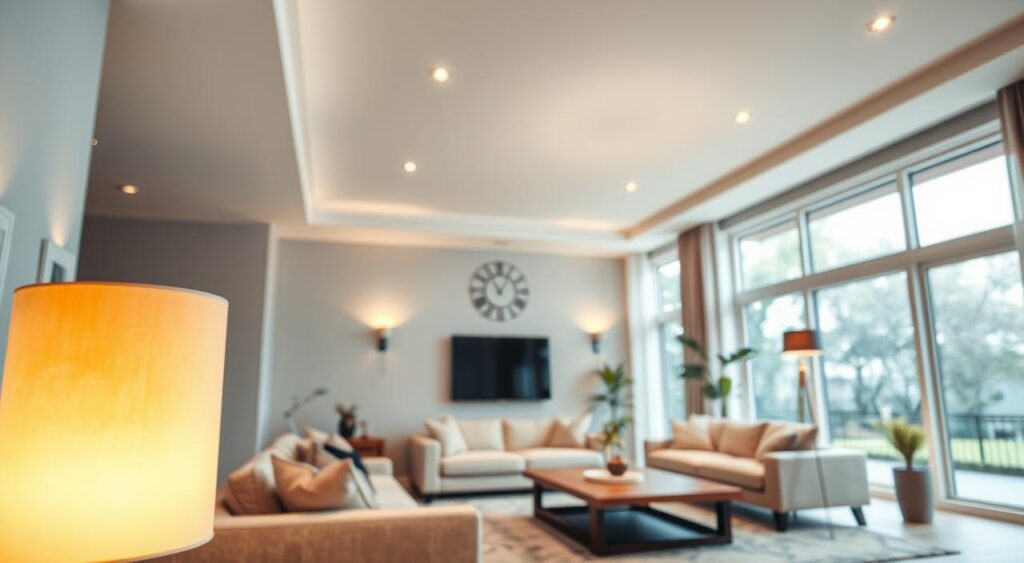
Start with the three types of lighting every room needs: ambient for overall glow, task for focused zones, and accent to highlight art or architecture. Think of them as a team—each plays a role in making spaces functional and beautiful. Mix overhead fixtures, table lamps, and sconces to layer light. Pro move? Pair 2700K soft white LEDs (800 lumens) for cozy vibes!
Choosing fixtures? Keep your style in mind. Love contemporary? Opt for sleek overhead cans or minimalist pendants. Traditional? Go bold with crystal chandeliers or wall sconces. Smart lighting is a game-changer too—voice-controlled lamps save time and energy. And don’t skip dimmers! A $20 switch lets you dial in moods from cozy to bright.
Maximize natural light with these beginner home decor ideas: Place mirrors opposite windows to bounce light around rooms. Use sheer curtains instead of heavy drapes. Even raise shades to let in more sun! In bathrooms, add overhead lights above sinks and wall sconces near mirrors. Kitchens? Combine bright overhead lights with under-cabinet pendants for prep zones.
Got a reading nook? Pair a floor lamp nearby. Dining rooms? A chandelier 30” above the table keeps meals bright. And remember—mix fixture heights to avoid that “everything’s stuck in the ceiling” look. Your space will thank you!
Textile Selection: Adding Warmth and Texture
Ever noticed how a chunky knit throw can instantly cozy up a sofa? Textiles are your secret weapon for turning sterile spaces into welcoming havens. Start with fabrics that match your lifestyle—like durable cotton for high-traffic areas or silky throws for statement-making flair. Let’s dive into beginner home decor ideas that transform rooms with texture.
Begin with basics like linen curtains—they’re breathable, stylish, and pair perfectly with velvet pillows. Mix patterns without overwhelm by following this rule: 70% neutral tones, 30% bold accents. Try layering a smooth silk throw over a nubby jute rug—textural contrasts create depth without chaos.
- Cotton: Soft, durable, and machine-washable—ideal for everyday use.
- Velvet: Adds instant luxury to upholstery or bedding.
- Wool: Naturally insulating and perfect for throw blankets.
“Texture is free rein for creativity—pair a raw-hemmed linen tablecloth with matte ceramic vases for instant visual rhythm.”
Swap out textiles seasonally for effortless updates. Trade lightweight linen pillows for chunky-knit versions in fall, or refresh a bed with a waffle-weave blanket. Easy home decor projects like DIY pillow shams (use no-sew iron-on hem tape!) let you experiment without sewing skills. And don’t forget floors—add a faux-fur rug in winter or a jute mat in spring for instant mood shifts.
Need inspiration? Mix materials like leather trinket trays with linen lampshades for contrast. Remember: texture layers should feel like a sensory journey, not a science experiment. Start small—update one room at a time and trust your touch.
Wall Treatments Beyond Basic Paint
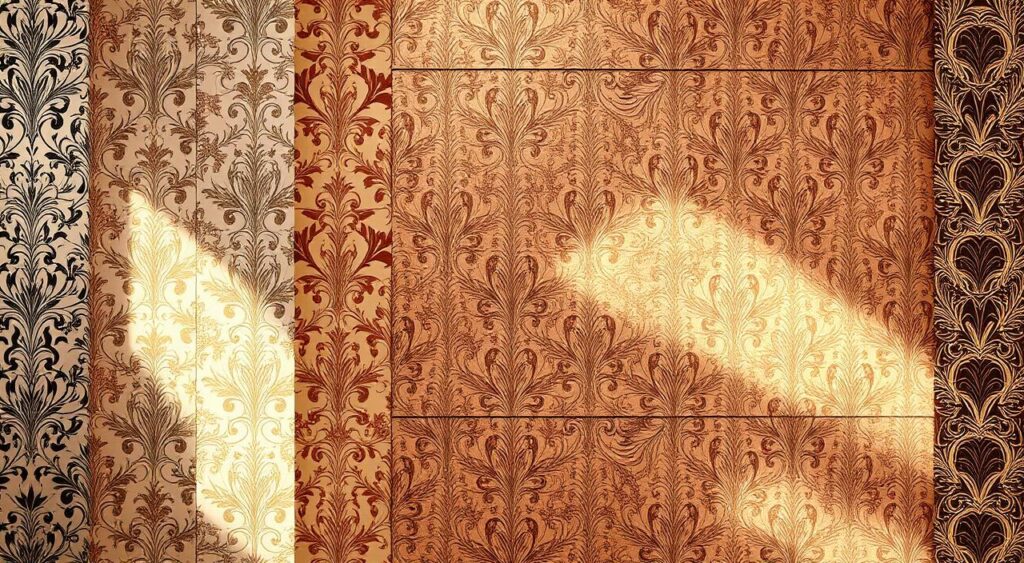
Ready to transform walls into focal points? Explore creative methods to introduce drama, texture, and personality beyond simple paint. Whether you’re a renter or embarking on a renovation, there’s a solution tailored for you!
Wallpaper Renaissance: Modern Patterns Made Accessible
Modern wallpapers are revolutionizing the game. Brands like Brewstix introduce peel-and-stick options with detailed patterns, from geometric shapes to floral designs. These patterns can be installed in mere minutes. Choose vertical stripes to elevate low ceilings or bold botanicals for small spaces. Remember, easy home decor projects like removable vinyl allow you to test trends without a long-term commitment!
Statement Walls Without Commitment
- Temporary murals (think tropical beaches or abstract art) that peel off cleanly
- Washi tape geometric borders for renters
- Fabric panels pinned to walls for a cozy, gallery-worthy look
Not sure where to start? Begin with DIY home decor for beginners like adhesive wall decals or chalkboard sections. My laundry room’s dark green Cloe tile, for instance, was achieved in just two hours, instantly elevating the space!
Texture Techniques for Visual Interest
Texture can be achieved without professional help. Try:
- Color washing for a weathered-chalk effect
- Textured paint rollers for subtle ridges
- 3D sculptural elements like interlocking foam tiles
Adhere to the 60-30-10 rule: 60% dominant color, 30% secondary, 10% accent. Mixing matte and glossy finishes adds depth without breaking the bank.
Textures such as tin tiles or Super Mod wood paneling (try light oak in geometric layouts) are perfect for kitchens or living areas. Even a 2×2 foot paint sample swatch stuck to a wall can test colors before making a full commitment!
Furniture Arrangement Strategies for Flow and Function
Let’s dive into the essence of home decorating tips that transform cluttered areas into inviting spaces. Begin by envisioning how you move through the room. This vision should guide your furniture arrangement. Adhering to a few key principles can significantly enhance your space: ensure 18” clearance between the sofa and coffee table, and place seating 3-10 feet apart for effortless conversation. These interior design basics simplify the process, eliminating the need for guesswork.
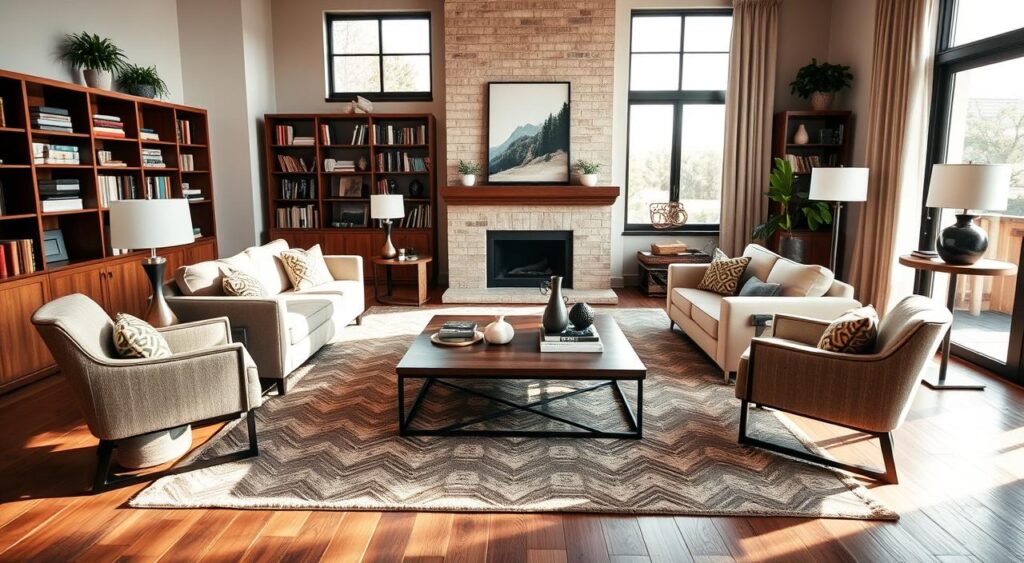
- Center layouts around focal points like fireplaces or windows
- Leave 30-36” of walkway space between furniture groupings
- Float sofas 3-5” from walls to create visual breathing room
Don’t overlook the vertical aspect! Combining tall bookshelves with low seating introduces a dynamic balance. In smaller areas, focus on multi-functional items such as storage benches or wall-mounted desks. Adopting a minimalist approach with floating shelves or slim-legged furniture can make rooms appear more spacious. Before moving heavy pieces, consider sketching out your layout on paper or use apps like RoomSketcher for virtual testing.
The golden ratio is a valuable guideline: a sofa should occupy two-thirds of the wall space. Coffee tables should mirror two-thirds of your sofa’s length if it’s rectangular. Always use a rug to anchor seating, ensuring the first two furniture legs are on the rug. These home decorating tips serve as a practical guide for creating spaces that are both refined and uniquely yours. Feel free to experiment, then refine your design until it flows smoothly, like a well-choreographed dance!
Accessorizing Without Clutter: The Art of Styling
Accessorizing smartly isn’t about stuffing your space with items. It’s about selecting pieces that resonate with you, without cluttering your space. Let’s explore three essential home decorating tips that transform collections into unified narratives. Are you ready to master the art of styling?
“Before you leave the house, look in the mirror and take one thing off.” — Coco Chanel
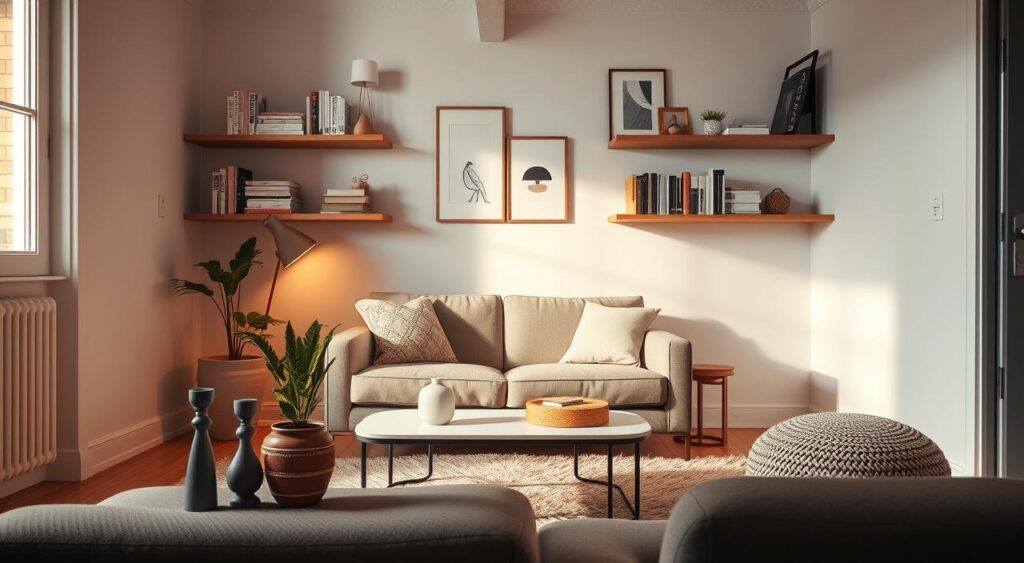
The Rule of Odd Numbers
Using odd numbers (3, 5, or 7) creates visual harmony. Imagine a set of three frames, perhaps from Target, paired with a vase and a book. Combine different heights and textures, like a tall vase next to a flat photo, to enhance each display. A smart move is to pair digital art prints with thrifted frames for a cost-effective look.
Create Storytelling Vignettes
Utilize the “tall + medium + short” formula to craft vignettes. For instance, a floor plant (tall), a medium bowl, and a small sculpture. Update your decor seasonally but keep 20% of it consistent. Swap out a fall pumpkin for winter greenery, not the entire arrangement. Store seasonal items in clear bins labeled by season for easy retrieval.
Seasonal Swaps, Zero Chaos
| Issue | Solution |
|---|---|
| Storage overflow | Invest in under-bed bins for seasonal items |
| Seasonal decor fatigue | Keep 20% seasonal pieces, 80% year-round staples |
| Overwhelmed by choices | Ask: Does this piece add joy or functionality? If not, let it go! |
Accessorizing is about purpose—each item should bring joy or serve a function. Adhere to these beginner home decor ideas to create spaces that feel welcoming, not cluttered. Your home’s narrative begins here!
Budget-Friendly Transformations That Make Big Impact
Ever dream of a space that looks like it’s straight from a magazine, but without the hefty price tag? I’m here to reveal how small tweaks can lead to significant visual enhancements. For instance, painting a single accent wall in charcoal or emerald can cost less than $20. This simple act can instantly transform a room. Swapping cabinet pulls for sleek brushed nickel hardware, a $15 investment, can give a 20-year-old kitchen a fresh, modern look. These affordable home decor ideas demonstrate that achieving big results doesn’t necessarily mean breaking the bank.
- Repaint a thrift-store chair in glossy white for a coastal vibe
- Use peel-and-stick wood plank decals on one wall for a rustic accent
- Layer IKEA’s $20 acrylic rugs in bold patterns for instant color pops
- Restyle old lamps with new drum shades from the dollar store
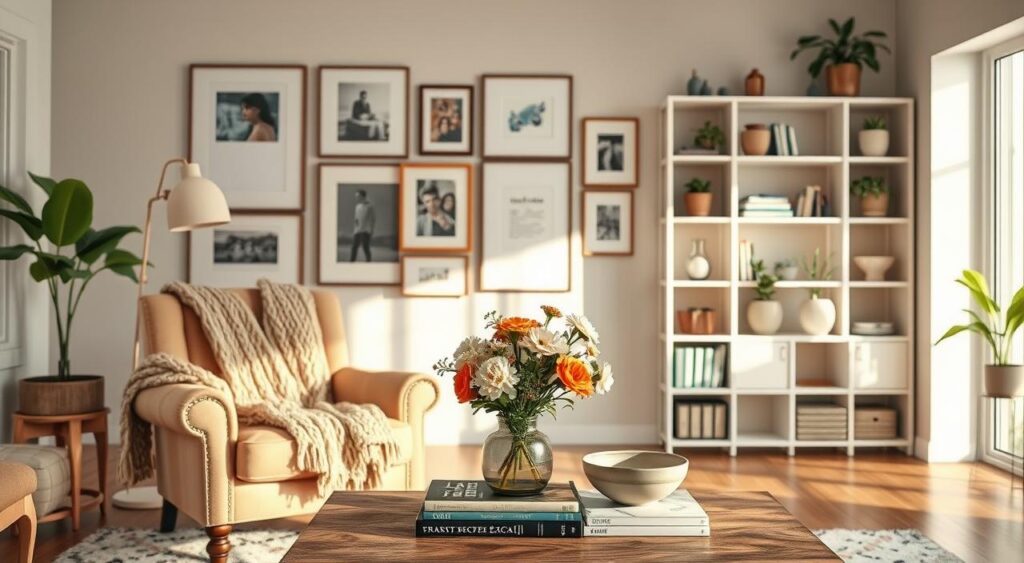
My go-to easy home decor projects often begin with items you already own. Try flipping a bookshelf against the wall to create a gallery display. Add washi tape grids to frames for instant symmetry. Swap bed linens in solid colors like navy or mustard to refresh a bedroom in minutes. DIY projects like remaking doors with chalk paint or turning scrap wood into wall art are perfect for a weekend project.
Invest wisely: A well-made sofa from Wayfair’s sale section can serve as a cornerstone piece. Pair it with Target’s $15 throw pillows in geometric patterns. Plants like fiddle-leaf figs (now sold at Walmart!) add life for under $30. Every choice should balance cost and impact—think LED strip lights under cabinets ($10 online) for mood lighting without rewiringings. Remember, creativity beats cash every time. What’s one thing you’ll try this weekend?
DIY Home Decor Projects for Absolute Beginners
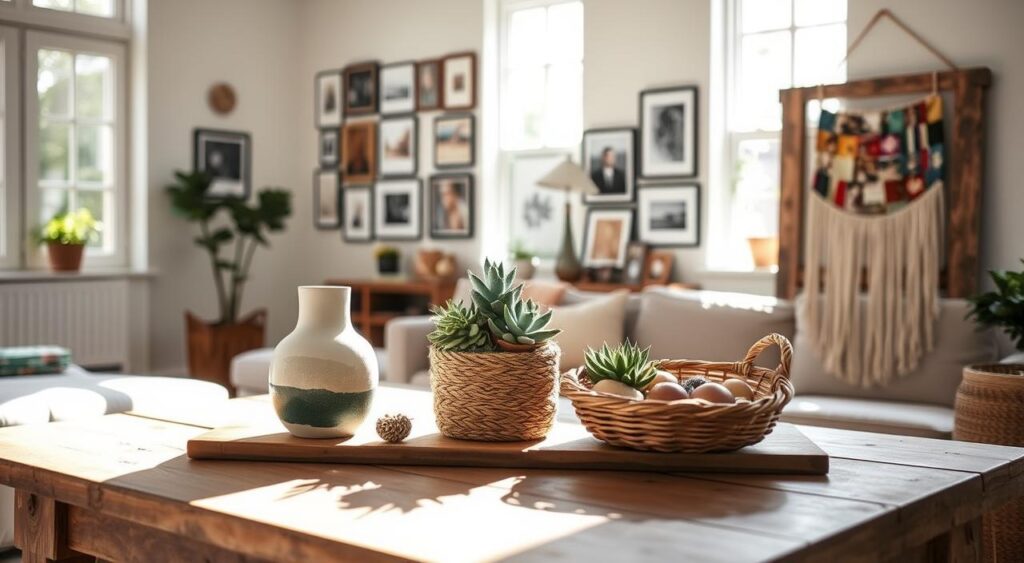
Ready to try DIY home decor for beginners but unsure where to begin? Let’s simplify it. With a 40% rise in DIY interest post-2020, it’s an ideal time to start. Imagine saving 50-75% on decor while creating spaces that reflect your unique style. No experience? No worries!
“I transformed my dull hallway into a gallery wall with board-and-batten boards—I spent just $20!” – Serena, Chicago DIY enthusiast
Begin with these easy home decor projects that need no sewing or power tools:
- No-sew projects: Wrap plain canvases in patterned fabric for instant art (try Target’s 15 easy DIY ideas)
- Upcycle basics: Spray-paint an old dresser in bold black for a modern update—Audra’s dark bedroom makeover cost under $50
- Weekend wins: Use peel-and-stick vinyl to create a faux brick accent wall in your kitchen
| Project | Time | Cost |
|---|---|---|
| No-sew throw pillows | 1 hour | $15 |
| Painted furniture legs | 2 hours | $8 |
| DIY gallery wall | 3 hours | $30 |
Struggling for ideas? Choose a room, like your living room or bedroom, and focus on one wall or piece at a time. Even a repurposed mason jar vase or painted tile can make a big difference. Your first project might seem daunting, but each success boosts your confidence. For inspiration, explore 15 easy DIY ideas with step-by-step guides. Remember, it’s the journey, not the perfection, that brings joy!
Room-by-Room Decorating Guide: Where to Start First
Embarking on a decorating project can seem daunting. Yet, with a well-thought-out plan, you can transform each room with ease. Begin with the space you frequent most, like your living room. It’s where memories are made and where guests first see your home.
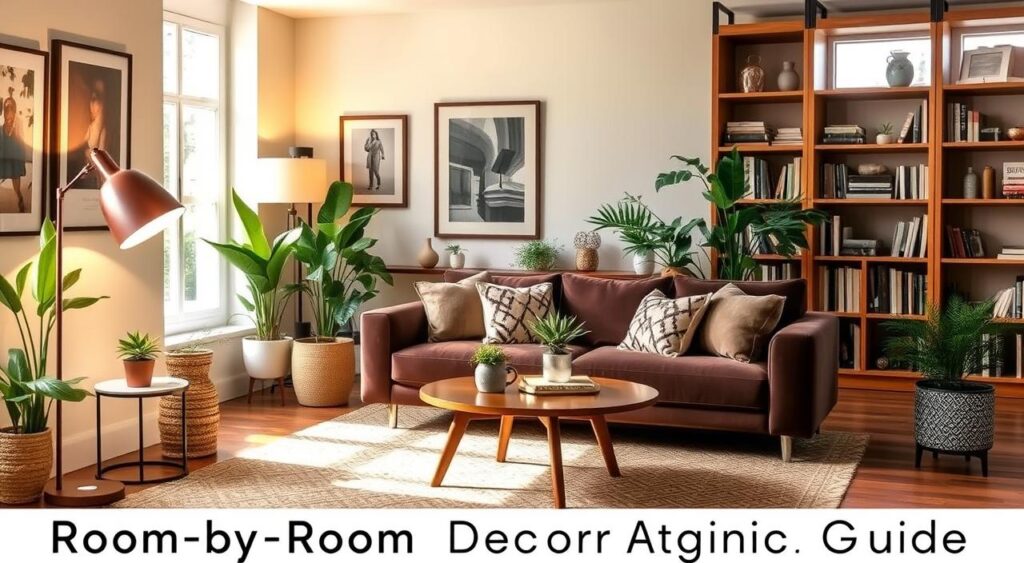
Here’s a straightforward beginner home decor ideas guide to keep you on track:
- Living Room: Begin by measuring the room. Use graph paper or online tools like Floorplanner.com to plan layouts. Choose a rug that’s big enough to tie the furniture together—think 9×12 or 10×14 sizes. Add pillows and throws for a cozy feel.
- Bedroom: Functionality should be your first priority. Place the bed as the centerpiece, ideally away from windows if you’re sensitive to light. Use lamps at eye level for reading comfort.
- Kitchen: Opt for built-ins or consoles to boost storage. Keep high-traffic areas clear to ensure smooth movement.
Looking for ideas? Create a Canva mood board to explore color and pattern combinations. Start small by rearranging furniture with painter’s tape before making any purchases. Each completed room serves as a learning experience for the next project!
“Progress, not perfection—decorate with intention, not urgency,”
Set aside 15 minutes each day for planning. Tackle one room at a time to see your home transform without overspending. Your dream space begins with a single step—where will you start?
Incorporating 2025 Home Decor Trends Thoughtfully
Ready to embrace 2025’s hottest styles without committing to a total overhaul? Let’s break down how to weave this year’s trends into your space with intention. Here’s how to stay on-trend without sacrificing your unique vibe—or no budget-busting splurges.
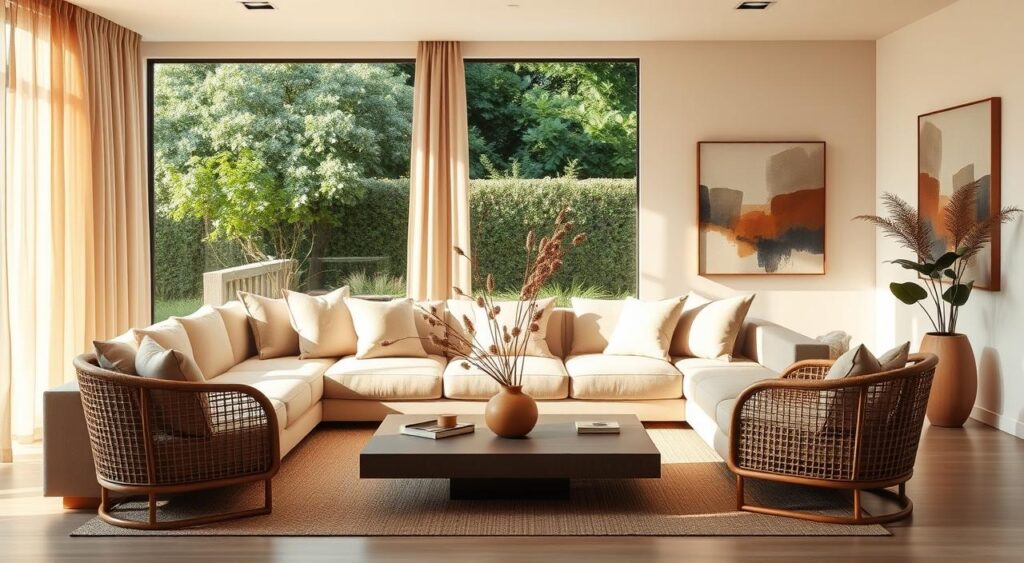
Start with sustainable materials. Swap synthetic fabrics for organic cotton or linen—check out how designers at 17vibes mix reclaimed wood accents with sleek tech for a timeless look. Reclaimed oak tables or recycled glassware add eco-cred without looking “hippie chic.”
Smart tech? Make it invisible. Hide charging hubs behind coffee tables or sync lighting with voice controls. Think wireless shades that dim automatically—convenience that doesn’t scream “gadget overload.”
Colors for 2025 lean toward grounded palettes. Moss greens, terracotta, and deep rusts create warmth. Add punch with navy or burnt orange in throw pillows or accent walls. Rule of thumb? Stick to one bold hue per room to avoid overwhelm.
- Pair earthy neutrals with metallic accents for instant sophistication.
- Refresh rooms with washable slipcovers instead of replacing upholstery.
- Swap outdated chrome for matte black hardware for an instant upgrade.
Remember—mixing trends with your personal style is key. Pick one bold piece (like a velvet sofa) and anchor it with classic neutrals. That’s how you stay stylish without chasing every fad!
Shopping Smart: Where to Splurge vs. Save
Ever pondered where to splurge and where to save in your home decor budget? Let’s dissect home decor 101 must-haves to illuminate affordable home decor ideas without breaking the bank!
Begin by investing in items that significantly impact your daily life. A high-quality sofa? Absolutely worth the cost. Opt for upholstered seating with robust frames and long-lasting fabrics. These pieces endure for over a decade, elevating comfort every day. Kitchen cabinets, whether hardwood or metal, also stand up to daily wear. And dining tables crafted from solid wood can become treasured family possessions. These are investments that yield long-term benefits.
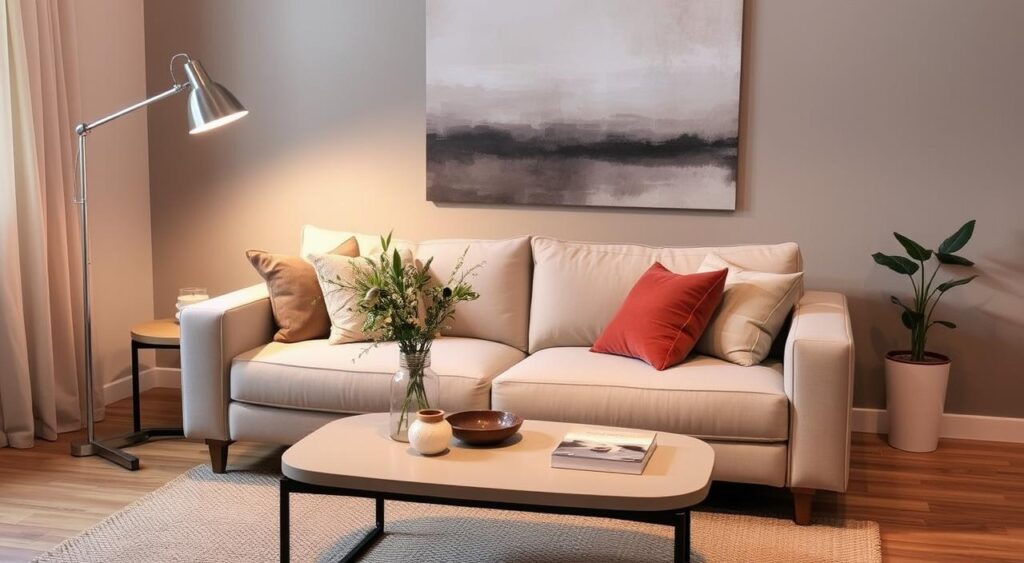
On the other hand, be frugal with accessories. Replace pricey throw pillows with more affordable options from IKEA or Target. Mixing patterns can refresh your decor without straining your wallet. Opt for timeless table lamps with classic designs, choosing budget-friendly models. Here’s a quick guide:
| Splurge | Save |
|---|---|
| Leather sectional sofas | Decorative throw blankets |
| Custom window treatments | Small-scale wall art |
| Stainless steel appliances | Seasonal decor accents |
“This candle warmer adds so much ambiance to my home office—no need to splurge on pricey candles!”
Focus on quality where it truly matters. A supportive mattress? Spend there—it enhances sleep and health. But splurge wisely! Combine smart investments with budget-friendly alternatives, and your space will exude luxury without financial strain. Every dollar is precious, yet knowing where to affordable home decor ideas truly excel is key. Happy decorating!
Evolving Your Space: How to Decorate for Changing Needs
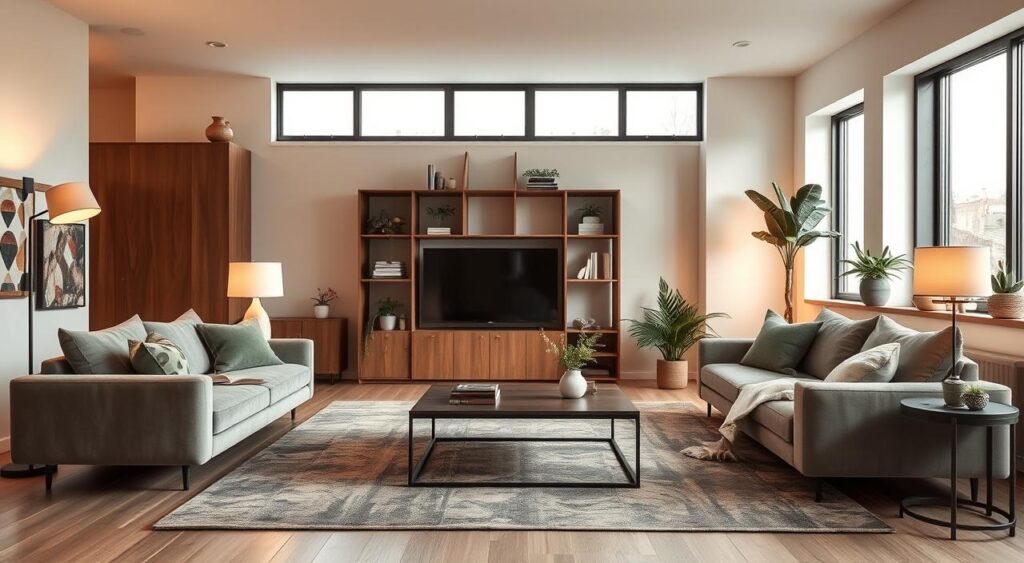
Life’s unpredictable, but smart design choices can keep your home fresh without breaking the bank. Whether you’re expecting a baby, working from home, or just want decor that lasts—these home decorating tips help you plan ahead. Start by choosing pieces that work as much as they look good.
| Strategy | How to Apply | Benefits |
|---|---|---|
| Modular Furniture | Invest in systems that adjust with family needs | Easily adapts to growing families |
| Multipurpose Zones | Use foldable desks and hidden storage | Blends work and relaxation seamlessly |
| Timeless Materials | Pick neutral tones and durable fabrics | Cuts costs over time |
Flexible Design for Growing Families
Modular sofas and adjustable desks are affordable home decor ideas that grow with kids. Swap out toys for books as they age—store old items in under-bed containers. Performance fabrics on couches stand up to spills and claws.
Adaptable Spaces for Work and Leisure
Turn a corner into a home office with a foldable table. Add abstract art to keep the vibe creative. Floating shelves hide cables, so your space stays clean.
Future-Proofing Decor Investments
Wider doorways and roll-under sinks make bathrooms accessible now and later. Neutral palettes let you refresh rooms with new art or pillows instead of full makeovers.
- Use Pinterest to pin inspiration and avoid buying mismatched decor
- Pair bold art with neutral walls for easy updates
- Rotate seasonal decor in storage bins to refresh spaces
Design that evolves with you doesn’t have to be complicated. Start small—swap a rug or repaint a wall. Your home will stay stylish, functional, and ready for whatever comes next.
Conclusion: Your Home Decor Journey Is a Marathon, Not a Sprint
Your home decor journey is not about achieving perfection. It’s about making progress. Every choice, from picking a sofa to arranging shelves, contributes to a space that truly reflects you. Remember the minimalist strategies we’ve discussed? They can reduce stress by 72% and save 20-30% on decor costs. These are the real victories.
Starting with home decor 101 basics like color theory or lighting is essential. Then, add personal touches with DIY home decor for beginners projects, such as repurposed shelves or handpicked art. Each small decision, whether it’s a new rug or a reorganized bookshelf, helps your space grow with you.
Be flexible with your goals. Maybe focus on the living room this year and the kitchen next. Budget-friendly updates like swapping throw pillows or rotating art keep your space fresh without a complete overhaul. And when in doubt, choose timeless pieces that adapt as your style evolves.
Decor is not a finish line but a story. Share your progress, ask questions, and celebrate every step. Your home should mirror who you are today and who you’re becoming. The best part? There’s no rush. Every room, every decision, is part of a journey that’s uniquely yours.
FAQ
What are some beginner home decor ideas to start with?
Begin by defining your personal aesthetic. Create Pinterest boards to gather inspiration. Focus on arranging furniture that is both functional and aesthetically pleasing. Experiment with simple accessories that reflect your style.
How can I create a cohesive color palette for my home?
Adopt the 60-30-10 rule for color selection. This means 60% of a dominant color, 30% of a secondary color, and 10% of an accent color. Choose colors that reflect your mood. Always test samples in different lighting conditions to ensure they feel right.
What accent pieces should I include to enhance my decor?
Choose items that resonate with you. Incorporate textiles like throw pillows and artwork that showcases your personality. Arrange decorative items in odd numbers to create visual interest.
How do I choose the right lighting for my rooms?
Use all three types of lighting—ambient, task, and accent—to illuminate your space beautifully. Select fixtures that complement your style. Optimize natural light with mirrors and window treatments.
What are some affordable home decor ideas for updating my space?
Try budget-friendly paint transformations for walls and furniture. Shop at thrift stores for unique finds. Explore DIY projects that allow you to customize items without breaking the bank.
How can I make my small space feel larger?
Use light colors on walls and opt for multi-functional furniture. Incorporate mirrors to reflect light. Keep the space uncluttered for better traffic flow and visual comfort.
What are some easy DIY home decor projects for beginners?
Start with no-sew textile projects like curtain hems or simple pillow covers. Upcycling items like glass jars into vases or creating wall art from fabric can elevate your space without complex skills.
How do I balance function and design in my home decor?
Prioritize items that serve dual purposes. Arrange furniture to accommodate daily activities. Ensure your space feels comfortable and flows well while being visually appealing.
What are some key home decor trends to look out for in 2025?
Expect a focus on sustainable materials and smart technology integration. Emerging color palettes will offer staying power. Incorporating these elements can keep your home feeling modern yet timeless.
How do I adapt my home decor for changing needs as my life evolves?
Choose versatile furniture pieces that grow with you. Create adaptable spaces. Think about multi-functional zones and design elements that are timeless yet practical to ensure longevity as your needs shift.
